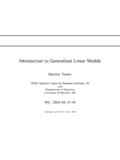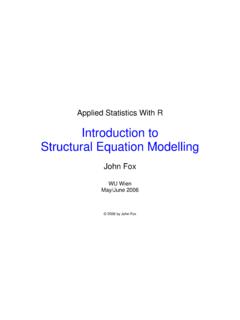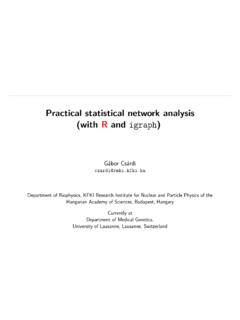Transcription of Item Response Theory in R using Package ltm
1 Item Response Theory in R using Package ltm Dimitris Rizopoulos Department of Biostatistics, Erasmus University Medical Center, the Netherlands Department of Statistics and Mathematics WU Wirtschaftsuniversit at Wien January 12th, 2010. Introduction Item Response Theory (IRT) plays nowadays a central role in the analysis and study of tests and item scores Application of IRT models can be found in many fields . psychometrics . educational sciences . sociometrics . medicine .. Seminar WU Wirtschaftsuniversit at Wien Jan 12th, 2010 1/26. Introduction A number of item Response models exist in the statistics and psychometric literature for the analysis of multiple discrete responses Goals of this talk.
2 Brief review of standard IRT models . estimation using marginal maximum likelihood . implementation in the freely available R Package ltm Seminar WU Wirtschaftsuniversit at Wien Jan 12th, 2010 2/26. IRT Models for Dichotomous Data Notation . xim: Response of the mth subject in the ith item . zm: latent variable ( , latent ability) typically, zm ( , ). We are interested in the relation between the probability of a positive ( , correct). Response in item i from subject m, and the value of her latent ability zm Pr(xim = 1 | zm; ). : parameters describing this relation Seminar WU Wirtschaftsuniversit at Wien Jan 12th, 2010 3/26.
3 IRT Models for Dichotomous Data (cont'd). The Rasch model exp(zm i). Pr(xim = 1 | zm; ) =. 1 + exp(zm i). where i is the difficulty parameter Properties and Features . closed-form sufficient statistics . all items have the same discrimination power . widely used Seminar WU Wirtschaftsuniversit at Wien Jan 12th, 2010 4/26. IRT Models for Dichotomous Data (cont'd). Easy Item Average Item Probability of Correct Response Difficult Item 3 2 1 0 1 2 3. z Seminar WU Wirtschaftsuniversit at Wien Jan 12th, 2010 5/26. IRT Models for Dichotomous Data (cont'd). The one-parameter logistic model exp{ (zm i)}. Pr(xim = 1 | zm; ) =. 1 + exp{ (zm i)}.
4 Where is a common discrimination parameter Properties and Features . common discrimination not fixed at one .. a bit more flexible than the Rasch model Seminar WU Wirtschaftsuniversit at Wien Jan 12th, 2010 6/26. IRT Models for Dichotomous Data (cont'd). The two-parameter logistic model exp{ i(zm i)}. Pr(xim = 1 | zm; ) =. 1 + exp{ i(zm i)}. where we now have a different discrimination parameter per item Properties and Features . no more closed-form sufficient statistics Seminar WU Wirtschaftsuniversit at Wien Jan 12th, 2010 7/26. IRT Models for Dichotomous Data (cont'd). Low Discrimination Average Discrimination Probability of Correct Response High Discrimination 3 2 1 0 1 2 3.
5 Z Seminar WU Wirtschaftsuniversit at Wien Jan 12th, 2010 8/26. IRT Models for Dichotomous Data (cont'd). The three-parameter model exp{ i(zm i)}. Pr(xim = 1 | zm; ) = ci + (1 ci). 1 + exp{ i(zm i)}. where ci is a guessing parameter Properties and Features . numerically less stable Seminar WU Wirtschaftsuniversit at Wien Jan 12th, 2010 9/26. IRT Models for Dichotomous Data (cont'd). Without Guessing Parameter With Guessing Parameter Probability of Correct Response 3 2 1 0 1 2 3. z Seminar WU Wirtschaftsuniversit at Wien Jan 12th, 2010 10/26. IRT Models for Polytomous Data Notation: the same as for dichotomous data but now xim can take Ki possible values Examples.
6 Bad , good , very good , and excellent .. very concerned , slightly concerned and not very concerned .. Seminar WU Wirtschaftsuniversit at Wien Jan 12th, 2010 11/26. IRT Models for Polytomous Data (cont'd). The generalized partial credit model (Masters, 1982; Muraki, 1992). P. k exp i(zm ic). c=0. Pr(xim = k | zm; ) =. P. Ki Pr exp i(zm ic). r=0 c=0. Properties and Features . Rasch version: i = 1 for all items . 1PL version: i = for all items . GPCM version: different i per item Seminar WU Wirtschaftsuniversit at Wien Jan 12th, 2010 12/26. IRT Models for Polytomous Data (cont'd). The graded Response model (Samejima, 1962).
7 Exp{ i(zm ik )}. Pr(xim k | zm; ) =. 1 + exp{ i(zm ik )}. Pr(xim = k | zm; ) = g( ik ) g( i,k+1). where ik = i(zm ik ), g( ) = exp( )/{1 + exp( )}, and 1 < 2 < .. < Ki Properties and Features . constrained version: i = for all items . unconstrained version: different i per item Seminar WU Wirtschaftsuniversit at Wien Jan 12th, 2010 13/26. Marginal Maximum Likelihood Estimation We assume that the subjects represent a random sample from a population and their ability is distributed according to a distribution function F (z) ( , Normal). We integrate out the latent abilities to obtain the marginal likelihood for the responses of the mth subject Z.
8 `m( ) = log p(xm; ) = log p(xm|zm; ) p(zm) dzm Conditional independence assumption: . given the latent variable value zm, the responses xm = (x1m, .. , xpm) in the p items are assumed independent Seminar WU Wirtschaftsuniversit at Wien Jan 12th, 2010 14/26. Marginal Maximum Likelihood Estimation To estimate the parameters we require a combination of . numerical integration because the above integral does not have a closed-form solution (Gaussian quadrature).. numerical optimization (EM, Newton-Raphson, quasi-Newton). Seminar WU Wirtschaftsuniversit at Wien Jan 12th, 2010 15/26. Estimating Latent Abilities After fitting the desired IRT model we often require to obtain an estimate for zm.
9 That is, what is the most plausible value of the latent ability for subject m given his responses xm and the assumed IRT model In particular, we are interested in p(xm | zm; ) p(zm). p(zm | xm; ) =. p(xm; ). Seminar WU Wirtschaftsuniversit at Wien Jan 12th, 2010 16/26. Estimating Latent Abilities (cont'd). Note that p(zm | xm; ) is a whole distribution we need a summary measure Maximum aposteriori z m = arg max{p(z | xm; )} = arg max{log p(xm | z; ) + log p(z)}. z z Expected aposteriori Z. z m = z p(z | xm; ) dz Seminar WU Wirtschaftsuniversit at Wien Jan 12th, 2010 17/26. 4 Design of Package ltm Package ltm can be freely downloaded from CRAN and perform IRT analysis under a marginal maximum likelihood approach the design of the Package is as follows 1.
10 Descriptive Analysis . descript(): descriptive statistics relevant to IRT.. (): pairwise associations . (): biserial correlation . (): calculates Cronbach's alpha . unidimTest(): unidimensionality check Seminar WU Wirtschaftsuniversit at Wien Jan 12th, 2010 18/26. 4 Design of Package ltm (cont'd). 2. Fitting IRT models . rasch(): Rasch and 1PL models . ltm(): 2PL and latent trait models with two latent variables (and nonlinear terms).. tpm(): three parameter model . gpcm(): generalized partial credit models (including the Rasch and 1PL versions).. grm(): graded Response model (including the constrained and unconstrained versions).











